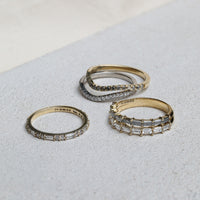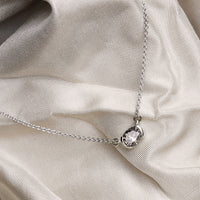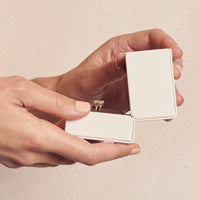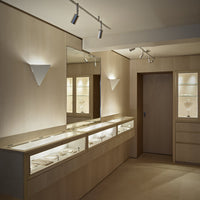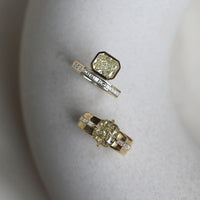

If anyone knows how to make a house a home, it's author and cognitive hypnotherapist Jessica Boston.
Stepping into her South West London abode feels more like entering the walls of a familiar sanctuary. There's a warming aura throughout; pocketed perfectly into delightful segments with every room sporting its own central colour palette, each embodying a different and yet cohesively-welcoming energy.
But this all comes as no surprise to those who know Jessica. In her first book, Homecoming Meditations: Exercises to Calm Your Mind & Find Your Inner Sanctuary, readers are encouraged to embark on a journey to rediscover this version of a familiar sanctuary for themselves, and all from within. We sat down with Jessica on the day of her book launch to find out more.

Hi, Jessica. It’s exciting to be sitting down with you at such a special time: the release day of your first book. How have you been feeling on the lead up to today and how are you feeling now that it’s out in the world?
I feel really proud, actually. For one, I have a book out in the world. But to have made something so rich in quality, and really abundant with what I would call “aha moments” through its meditations and exercises, presented beautifully and in a way that works with how the subconscious mind works — makes me very proud. Metaphor is one of the most powerful vehicles we have for change, and this book will really take you on a journey back home to yourself.
Can you explain a little about your work and what 'Homecoming Meditations' is about?
I’m a hypnotherapist. I work primarily with women, guiding them to trust themselves after trauma — and in many cases — helping them to trust themselves for the first time in their lives.
I run a one-to-one healing programme called Homecoming where we work through your issues and the physical symptoms of stress and anxiety in the body that manifest as a result. I’ve used the home as a central analogy in my work for years because the idea of a homecoming is inherently spiritual: a returning home to the self.
When you work with trauma, dissociation can be very real, and often existential ideas around healing and the self are really helped by having a vessel (or concept) that the breakthroughs are rooted in. Both my programme and book take you around the ‘home’ that is you through exploring different facets of the self. For example, The Gates are your relationship with boundaries, The Attic is your memories and The Garden is growth. Your healing is grounded in both practical and magical ways.
Jessica wears the Amaranth Necklace – 3.16ct Tourmaline, Viburnum Necklace – 6.65ct Watermelon Tourmaline, Zinnia Necklace – 1.84ct Tourmaline and the Medium Knife Edge Necklace.

What do you think the benefits are to books in particular as a medium for inner healing?
Books give you back time because they don’t rush your nervous system. We are so distracted by technology, with our lives moving and changing so fast. When I designed this book, I wanted it to force the reader to slow down; to recreate that feeling of being a child, being read to lovingly, without being patronised. By enjoying the beauty of the illustrations, connecting bigger and more complicated ideas about the mind, body, nervous system, the subconscious mind and what it needs to heal is made so much easier.
Learning is connecting, and a book lets you build a relationship with an idea until it is yours. The images work with metaphor, which is the native language of the subconscious, and are combined throughout with powerful practical interventions and protocols. And, as you evolve, you are likely to discover new ideas every time you pick it up.

In your experience, what is the metaphorical room that people struggle with the most? The door that is usually kept locked, with the key thrown away?
I would say the attic, although we never really throw the key away, rather simply hide it. This is a room where shadows live; where we keep ideas that we’re ashamed or afraid of.
Since there is shame or secrecy involved, people push these things away and don’t want to see or experience them. On our journey in the book (and through my programme), we build foundations of trust first before we explore the attic. There has to be a level of safety before you can explore the shadowy realms of the self.
What to you defines a home? Is it family, a feeling, a physical space?
Personally for me, a home is light and warmth. In trauma, we lose light, warmth and connection from the body, with the shadows taking over to protect us. To return home is to return the light and warmth within; for the rooms inside to connect back together and return to integration, wholeness, choice and consideration.
It’s also where my people are. I love going out, but my favourite thing is coming back to my fiancé and my dog Lorenzo (who’s also in the book, if you can find him!). If I come back late and see the lights still on, I get a cuddle and a kiss goodnight. That’s the best feeling.
Jessica wears the Decontra Earrings.

Speaking of your people, Rachel is your younger sister and designed your engagement ring alongside your partner. Were you a part of this process? How does it feel for you to have her be a part of this special life moment?
It was a dream. I had no idea it was happening and I’m not easy to surprise [laughs]. I was not part of the design at all. Rachel and Dre quietly conspired together, which I loved. They both know my taste inside out.
I’m not so into the subtle, small or demure jewellery. I like big, layered, chunky. A story. I also like nature, shells, crystals and pearls, and so the black pearl around the diamonds is so special. I cannot get enough of the way it switches from pink to green when it catches the light, reminding me a lot of the Oz films.
It's so beautiful and when I look at it, I remember the day he proposed on a beach in Morocco and I feel loved. I see the story of us in it. The whole ring makes me feel understood and seen, and that’s a special feeling.
On her ring finger, Jessica wears a bespoke engagement ring by Rachel Boston. Featuring a 0.69ct Oval Cut diamond, framed by a double halo of black Mother of Pearl and additional pave diamonds.

Being here in your home it’s obvious that it’s a very intentional space. Every room is a different colour and each hold objects that look like they have been collected with love over time. What are some particular things in your physical space that bring you joy and keep you grounded?
Culture makes me feel alive, expansive and excited. I believe it to be a remedy to a lot of the world’s ills, reminding us that more unites us than divides us. I love to travel, to learn how other people live and make art, for both survival and for beauty.
Around my house you might see things from Jamaica, India, Venezuela (where my mother is from). My fiancé and I both adore Morocco and its style and will often go on missions to buy Tamegroute pottery when we’re there.
There are certain artworks I can’t get enough of, especially portraits of women or any form of tapestry like Haitian beaded and sequin pieces. In my office I keep posters from my meditation albums, as well as commissioned art pieces I had made for a meditation video project.
I like a home to be a small museum reflective of the life of the people in it. To have little corners of interesting, curious items: knick-knacks, altars and stories.


Jessica wears the Decontra Earrings.
What’s one piece of advice you’d give to someone who’s struggling to define what home means to them?
At the beginning of the book there’s a chapter on what ‘home’ is, and although the definition is uplifting and positive, there’s a reminder that for many, home is not that. It can also at times be lonely or sad, but ultimately, it can be defined by you.
It doesn’t have to be perfect or cookie cutter. It doesn’t have to be always happy. Home is about choosing what home is for you. Maybe it’s a feeling or a word, but it doesn’t have to be pressurised or aspirational. It can simply be something you define on your own terms, in your own style, built on your own choices.


